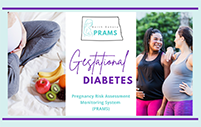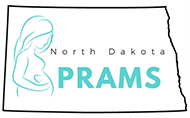Ask A Researcher
August 2022
Gestational Diabetes PRAMS Points – A NEW Dashboard Format!

The North Dakota Department of Health and the Center for Social Research (CSR) at North Dakota State University (NDSU) continue their collaboration with the North Dakota Pregnancy Risk Assessment Monitoring System (PRAMS), a project that focuses on gathering state-specific data on maternal attitudes and experiences before, during, and shortly after pregnancy to improve the health of mothers and infants. Kendra Erickson-Dockter is a research specialist with the CSR and provides support for projects, such as PRAMS, SOARS, and North Dakota Compass. Kendra received her master’s degree in Sociology at NDSU.
The North Dakota Pregnancy Risk Assessment Monitoring System (PRAMS) is a collaborative surveillance project of the Centers for Disease Control and Prevention (CDC), the North Dakota Department of Health, and the Center for Social Research at North Dakota State University. PRAMS collects state-specific data on maternal attitudes and experiences before, during, and shortly after pregnancy, with the overall goal of reducing infant morbidity and mortality.
To help disseminate study results, a series of analysis documents, PRAMS Points, are being released on a variety of topics such as oral health, safe sleep, gestational diabetes, and substance use. First to be released in this series was the 2021 PRAMS Points: Pregnancy and Oral Health in a PDF format. To allow for easier updating of the data, the format of the PRAMS Points changed in 2022 from a PDF document into a more interactive-style dashboard.
This article overviews data regarding gestational diabetes in pregnant women in North Dakota as displayed in the first PRAMS Points Dashboard. The dashboard uses data from North Dakota PRAMS gathered from 2017 through 2020 to examine the prevalence of gestational diabetes and the associated maternal characteristics, outcomes, and health care provider related questions and information. Dashboards such as this, contribute to the ongoing surveillance efforts that can identify populations at risk and help create and evaluate programming and policies to improve health outcomes for pregnant women, babies, and mothers.
Gestational Diabetes Background
Gestational diabetes is a type of diabetes that develops in pregnant women who do not have diabetes prior to pregnancy. Like other types of diabetes, gestational diabetes impacts how the body’s cells use sugar (glucose) and cause blood sugar levels to become too high in the body (1, 2, 3). Gestational diabetes usually develops around week 24 of a pregnancy; therefore, women are typically tested for the condition between pregnancy week 24 and 28. Women deemed high risk for gestational diabetes may be tested earlier by their health care provider (1, 3, 4).
It is important that pregnant women are tested, and treatment begins if necessary to protect the mother and baby’s health, as symptoms for gestational diabetes typically do not present themselves. Fortunately, gestational diabetes can largely be controlled by monitoring blood sugar, a healthy diet, and being active. However, if left untreated, the condition can negatively impact the health of pregnant women and their babies, such as an increased risk of having a cesarean delivery, preterm delivery, or babies born with an excessively heavy birth weight (1, 2, 3, 4).
Gestational Diabetes Data and Trends
On average, in the United States approximately 7 percent of pregnancies are affected by gestational diabetes; however, prevalence can vary, and the condition can affect between 2 percent and 10 percent of pregnancies each year (1, 3, 5).
In North Dakota, on average 9 percent of pregnant women had gestational diabetes during their last pregnancy according to PRAMS data collected in 2017 through 2020. During this same time, the annual ND PRAMS gestational diabetes data show an upward trend of the condition in the state.
Click the dashboard’s DATA & TRENDS tab to explore statewide gestational diabetes data!
Maternal Characteristics Impacting Gestational Diabetes
The risk of developing gestational diabetes in pregnant women differs by a variety of demographic and health characteristics (e.g., age, race, body weight). These characteristics or risk factors are important to track because they may suggest higher prevalence of gestational diabetes to health care providers or need for education or programming.
According to North Dakota PRAMS data (2017 - 2020), when comparing groups within various characteristics, gestational diabetes was most prevalent among women who were:
· Age 40 or older.
· Overweight or obese prior to pregnancy.
Specifically, the prevalence of having gestational diabetes in North Dakota increases as pregnant women’s age increases. Three in 10 pregnant women, age 40 and older, had gestational diabetes (29%) compared to 11 percent of 30- to 39-year old pregnant women and 8 percent 20- to 29-year old pregnant women (North Dakota PRAMS data, 2017-2020). See interactive data on dashboard.
According to North Dakota PRAMS data (2017-2020), the prevalence of having gestational diabetes increases as pregnant women’s pre-pregnancy BMI (Body Mass Index) increases. One in 7 pregnant women who were obese (BMI 30.0 or higher) prior to pregnancy had gestational diabetes (15%) and 12 percent of those who were overweight (BMI 25.0 – 29.9) compared to 4 percent of those pregnant women who had a normal BMI (18.5 – 24.9) prior to pregnancy. See interactive data on dashboard.
Although 2017-2020 North Dakota PRAMS data may not have shown differences in prevalence of gestational diabetes among groups due to a low number of observations, literature suggests the following risk factors of developing gestational diabetes:
· Being of a certain race and ethnicity (i.e., African American, Alaska Native, American Indian, Native Hawaiian, Pacific Islander, or Hispanic) (6, 2, 3).
· Having had gestational diabetes in a previous pregnancy (6, 2).
· Having prediabetes (2).
· Having a family history of diabetes (6, 2, 3).
· Previously giving birth to a baby with an excessively heavy birth weight (6, 3).
Delve into data breakdowns by clicking the dashboard’s MATERNAL CHARACTERISTICS tab!
Associated Outcomes with Gestational Diabetes
If not carefully managed, gestational diabetes can increase the likelihood of experiencing associated outcomes that can negatively impact pregnant women, mothers, and babies. These outcomes are important to track and can inform health care providers and expectant mothers of potential risks. This greater awareness can then lead to approaches to respond to potential complications.
According to North Dakota PRAMS data collected from 2017 through 2020, when comparing women who had gestational diabetes and those who did not have gestational diabetes during their most recent pregnancy,
· A much higher percentage of women who had gestational diabetes developed high blood pressure during their last pregnancy (preeclampsia or eclampsia).
· A higher percentage of babies born to women who had gestational diabetes during their last pregnancy stayed longer in the hospital (3-5 days).
Although 2017-2020 North Dakota PRAMS data may not have shown differences between the gestational diabetes groups due to a low number of observations, literature suggests the following potential outcomes associated with gestational diabetes.
For Pregnant Women, having gestational diabetes during her pregnancy increased the likelihood of:
· Having a miscarriage or stillborn baby (2, 7).
· Having a preterm birth (baby born too early) (1, 2, 7).
· Having a cesarean section delivery (1, 2, 7).
For Babies, having gestational diabetes during the mother’s pregnancy increased the likelihood of:
· The baby born with an excessive birth weight (1, 2, 7).
· The baby having low blood sugar (hypoglycemia) right after birth (1, 2, 7).
· The baby having breathing problems (1, 2, 7).
· The baby developing type 2 diabetes and obesity later in life (1, 2, 7).
For Women After Birth, having gestational diabetes during her pregnancy increased the likelihood of:
· The woman developing type 2 diabetes later in life (1, 2, 7).
Pre- and Post-Pregnancy Care with a Health Care Provider
One of the best ways of promoting successful outcomes for both baby and mother, is to have a healthy pregnancy and after birth recovery. To improve the chances of having a healthy pregnancy and postpartum care is to start and continue regular prenatal and pre-and post-pregnancy care with a health care provider to get information, ask questions, and discuss concerns (8).
According to North Dakota PRAMS data collected from 2017 through 2020, when focusing on women who had gestational diabetes during their last pregnancy and who went to the following health care visits:
· 7 in 10 women were NOT talked to by a health care provider about how to improve their health before pregnancy during any of their health care visits in the 12 months before they became pregnant (69%).
· 3 in 5 women were asked by a health care provider if they knew how much weight they should gain during pregnancy in any of their prenatal care visits (59%).
· 1 in 2 women were NOT talked to by a health care provider about healthy eating, exercise, and losing weight gained during pregnancy at their postpartum checkup (53%).
· 1 in 2 women were tested for diabetes at their postpartum checkup (48%).
Find more health care provider information data in the dashboard’s PROVIDER QUESTIONS tab!
References
(1) Centers for Disease Control and Prevention. Diabetes: Gestational diabetes. (August 10, 2021). Retrieved April 2022 from https://www.cdc.gov/diabetes/basics/gestational.html.
(2) Mayo Clinic. Gestational diabetes. Symptoms & causes. Retrieved April 2022 from https://www.mayoclinic.org/diseases-conditions/gestational-diabetes/symptoms-causes/syc-20355339.
(3) Cleveland Clinic. Gestational diabetes. (January 14, 2021). Retrieved April 2022 from https://my.clevelandclinic.org/health/diseases/9012-gestational-diabetes.
(4) Mayo Clinic. Gestational diabetes. Diagnosis & treatment. Retrieved April 2022 from https://www.mayoclinic.org/diseases-conditions/gestational-diabetes/diagnosis-treatment/drc-20355345.
(5) National Institutes of Health, National Library of Medicine, MedlinePlus. (June 15, 2020). Retrieved April 2022 from https://medlineplus.gov/diabetesandpregnancy.html.
(6) Centers for Disease Control and Prevention. Diabetes: Diabetes risk factors. (April 5, 2022). Retrieved April 2022 from https://www.cdc.gov/diabetes/basics/risk-factors.html.
(7) National Institutes of Health, National Institute of Diabetes and Digestive and Kidney Disease. (May 2017). Retrieved April 2022 from https://www.niddk.nih.gov/health-information/diabetes/overview/what-is-diabetes/gestational/definition-facts.
(8) National Institutes of Health, Eunice Kennedy Shriver National Institute of Child Health and Human Development. (January 31, 2017). Retrieved April 2022 from https://www.nichd.nih.gov/health/topics/pregnancy/conditioninfo/prenatal-care.
PRAMS Information
More information about the PRAMS project and PRAMS data can be found at www.health.nd.gov/prams.
Explore the NEW PRAMS Points Gestational Diabetes Dashboard today!

Other PRAMS POINTS
• Pregnancy and Oral Health (May 2021)
• Babies Safe Sleep (Coming Soon)
• Pregnancy and Diabetes (Coming Soon)
